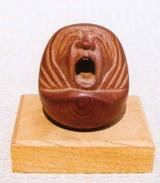:::::::::::::::::::::::::::::::::::::::::::::::::::::::::::::::::::::::::::::::::::::::::::::::::::::
Chindonya ちんどん屋 street musician
commercial street band
advertising street band

source : pegasus_es2004

PHOTO : ajinatora.exblog.jp
Street musician with Daruma at the Mihara Daruma Market
三原市のダルマ市
. Mihara Daruma 三原だるま .
:::::::::::::::::::::::::::::::::::::::::::::::::::::::::::::::::::::::::::::::::::::::::::::::::::
quote
Chindon'ya (チンドン屋),
also called Japanese marching band, and in the old times also called
tōzaiya (東西屋) or
hiromeya (広目屋 or 披露目屋)
are a type of elaborately costumed street musicians in Japan that advertise for shops and other establishments.
The performers advertised the opening of new stores and other venues, or promoted special events such as price discounts. Nowadays, chindon'yas are rare in Japan. The word consists of Japanese sound symbolism chin and don to describe the instruments, and the -ya suffix which roughly equates to the English "-er" suffix in this context.
Origin as single performers in Osaka
Street performers existed in Japan for a long time. However, the connection with advertising forming a chindon'ya first appeared in Osaka during the 19th century (Late Edo period and early Meiji period) at the beginning of industrialization. The first known chindon'ya is generally considered to be a candy seller in Osaka named Amekatsu, who around 1845 used singing and a noise making toy to attract attention to his own portable candy stall, as many other salespeople, especially candy sellers. Due to his strong voice he was well known in Osaka, and hence tried to sell not candy but rather advertise for other stores and a theater, wearing a large hat and straw sandals, and small bells at his belt, and used a wooden hyogoshi noisemaker. He was succeeded by a former bath attendant Isamikame, who also used to shout tozai (Literally East-West, equivalent to Listen up or welcome (come one come all)).
Subsequently, such advertising street performers were called tozaiya in Osaka up to World War II. He soon received competition from another advertiser called Matemoto, and they split their business, with one covering the Uemachi region and the other covering the Shinmachi region of Osaka.
After Maemoto died in 1891, his brother, also called Maemoto took over the business, and he was soon joined by his son and daughter, probably the first female chindon'ya. Maemoto is also famous as being the first person in Osaka to die from electric shock in 1893. Other well known performers from this time are Tanbataya Kurimaru, a former Sweet Chestnut seller, and Satsumaya Imosuke, a former bean seller. These two also occasionally added a second performer to their band.
Group performers in Tokyo
At the early Meiji period, such advertising was still unknown in Tokyo, and advertising was mainly done on curtains (noren), billboards (kanban), and flyers (hikifuda). Stalls also advertised for themselves by making noise and wearing colorful clothes, a at the time widely known example being the extremely colorful dressed pharmacist Iwashiya.

During this time, newspapers and posters also started to appear in Japan and were used for advertising. The military also started to popularize western style marching bands, and at the same time public bands started to appear. In1885 an advertising agency in Tokyo hiromeya(wide eyes) hired musicians for advertising.
Hiromeya was founded by a former tozaiya from Osaka Akita Ryukichi. He soon found out that a one person band was not as popular in Tokyo as in Osaka, and hired larger bands of more than 10 performers for advertising purposes, following the popularity of military and public bands. His band also provided entertainment at festivals and parties, and also created background music for silent films. He was also hired by the Kirin beer company, whose advertising campaign spread out to Osaka.
In Osaka, this form of group bands was yet unknown, as only individual performers were hired for advertising. The police also had to stop some of the larger performances in Osaka, as they hindered traffic, partially also caused by the 2 meter tall beer bottle the group was equipped with. The Hiromeya business grew, and they were even asked to perform at the burial of Emperor Meiji in 1912. The business still exists nowadays, although they now do mainly decorations.
MORE
© More in the WIKIPEDIA !
:::::::::::::::::::::::::::::::::::::::::::::::::::::::::::::::::::::::::::::::::::::::::::::::::::::

source : shotokimura.web. Librairie Seizan
Listen to their music!
美しき天然
source : www.youtube.com
ちんどん通信社〜(有)東西屋 Their History in Japanese
source : www.tozaiya.co.jp/history

. . . CLICK here for Photos !
:::::::::::::::::::::::::::::::::::::::::::::::::::::::::::::::::::::::::::::::::::::::::::::::::::::
Chindonya
By ALICE GORDENKER
... There are also amateur and student troupes. A good place to check out the state of the industry is the Chindonya Championship, held every April in Toyama City, Toyama Prefecture.
source : Japan Times, July 17, 2012
:::::::::::::::::::::::::::::::::::::::::::::::::::::::::::::::::::::::::::::::::::::::::::::::::::::::

Nakamura Gakuryoo 中村岳陵 Gakuryo Nakamura 中村岳陵
(1890-1969)
:::::::::::::::::::::::::::::::::::::::::::::::::::::::::::::::::::::::::::::::::::::::::::::::::::::::
初燕今日の為なるちんどん屋
hatsu tsubame kyoo no tame naru chindonya
the first swallow -
a Chindonya band
just for today

Haiku by Hoshino Tsubaki 星野椿先生
On the occasion of the great Haiku Meeting in Komuro
信州小諸 全国俳句大会
source : chindonband
. Hoshino Tsubaki 星野 椿 .
:::::::::::::::::::::::::::::::::::::::::::::::::::::::::::::::::::::::::::::::::::::::::::::::::::::
. gannin boozu 願人坊主 mendicant monks .
performing all kinds of performances at the roadside
[ . BACK to DARUMA MUSEUM TOP . ]
[ . BACK to WORLDKIGO . TOP . ]
:::::::::::::::::::::::::::::::::::::::::::::::::::::::::::::::::::::::::::::::::::::::::::::::::::::









No comments:
Post a Comment